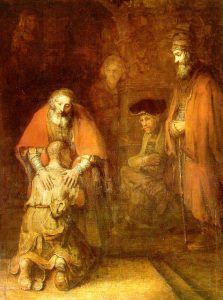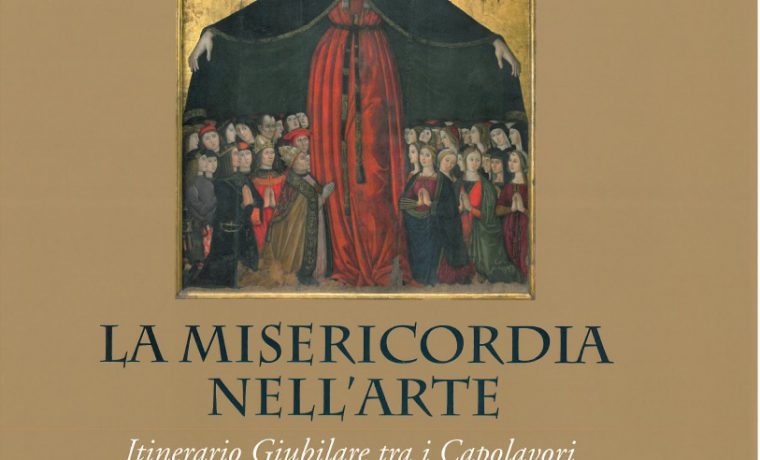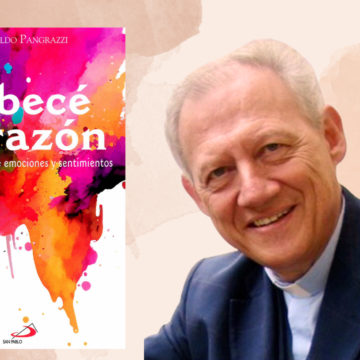 La misericordia nell’arte, Itinerario giubilare tra i Capolavori dei grandi artisti Italiani (‘Mercy in Art: a Jubilee Itinerary amongst the Masterpieces of Great Italian Artists’), edited by Maria Grazie Bernardini and Mario Lolli Ghetti (Gangemi Editore, Rome, 2016).
La misericordia nell’arte, Itinerario giubilare tra i Capolavori dei grandi artisti Italiani (‘Mercy in Art: a Jubilee Itinerary amongst the Masterpieces of Great Italian Artists’), edited by Maria Grazie Bernardini and Mario Lolli Ghetti (Gangemi Editore, Rome, 2016).
The poet Charles Péguy put sublime words into the mouth of God: ‘Charity does not amaze me. It is not surprising in itself. It is that these poor creatures who are so unhappy, if they not have a heart of stone, can but have charity towards each other’ (Charles Péguy, Le parole da la deuxième vertu). But do these words correspond to the truth? The truth, however, is that mercy is not very much loved and as early as 1980, in the second encyclical of his pontificate which was consecrated to mercy – and this well shows how dear the subject was to him – Pope John Paul II observed: ‘The present-day mentality, more perhaps than that of people in the past, seems opposed to a God of mercy, and in fact tends to exclude from life and to remove from the human heart the very idea of mercy. The word and the concept of “mercy” seem to cause uneasiness in man, who, thanks to the enormous development of science and technology, never before known in history, has become the master of the earth and has subdued and dominated it’ (Dives in misericordia, n. 2).
And suffering today is certainly not on a lesser scale. Wherever you look, the heart bleeds at the sight of the miseries that surround us: the long processions of those who are fleeing from war; the victims of a blind terrorism that leads us to think that a sort of third world war is being unleashed by ‘pieces’, to use a phrase of Pope Francis; not to mention maltreated children, old people abandoned to homes where nobody pays them a visit, violence in the home and oppression of every kind…
There was thus an urgent need to force the heart of contemporary man and oblige him to bend down to the miseries of the world. Because this is the meaning of the term. Mercy, indeed, precisely demonstrates the love that is expressed towards those who suffer. And we well know that it is one of the first qualities – one of the first predicates theologians would say – of God Himself. When the people of the first covenant felt that it was on the edge of an abyss, it turned to Him whom it wanted to be its Shepherd and prayed to Him with the name of ‘God of mercy’. ‘You who fear the Lord, expect his mercy’ (Sir 2:7), because ‘his mercy is great’ (1Cor 21:13). One could thus say that it is infinite.
The mercy of God became flesh in Jesus Christ and this was not only one of the themes of his preaching but was also revealed in a perfect way when he accepted the cross as a journey towards the resurrection. The parable that most evokes this is that of the prodigal son (Lk 15:11-32): in it, the mercy of God finds its most limpid representation.
 Painters have understood this very well. In the Hermitage Museum of St. Petersburg a picture by Rembrandt occupies a large space on the wall. And it is so famous, and reproduced so much, that there is almost no need to talk about it; its power to evoke remains, however, unequalled. After a life spent in wasting the whole of his inheritance in a life of pleasure, the prodigal son decided to return home. His clothes are torn, he is walking barefoot like a slave; he is to be seen kneeling in front of his father while he beats his chest and keeps his eyes closed out of shame. His father is elderly, with a long beard that has grown grey with the displeasure of the separation and with empty waiting. He has a long red cloak, the colour of good and light. And it is, in fact, this light that attracts and fixes the gaze of the person looking at this painting. The father also keeps his eyes closed, but he does this so as not to see the failings of his son: his head is bowed in a sign of affection and mercy and his hands are on the shoulders of a son who has decided to return home, and he is ready to restore him to the condition of being a son of his family. On his mouth there is no rebuke, no admonition, no intention to put him to the test, while the onlookers – friends and servants (and we with them) – are paralysed by surprise. From their approach transpire irony and doubt, as though for them forgiveness is improbable, even impossible. The older brother, hidden behind a column – the image of a sense of duty that has no access to penitence and tenderness – refuses to take part in the celebrations. Immersed in his inner joy, the father can only repeat the words: ‘My son was dead and has come back to life, he was lost and now he has been found’ (Lk 15:32).
Painters have understood this very well. In the Hermitage Museum of St. Petersburg a picture by Rembrandt occupies a large space on the wall. And it is so famous, and reproduced so much, that there is almost no need to talk about it; its power to evoke remains, however, unequalled. After a life spent in wasting the whole of his inheritance in a life of pleasure, the prodigal son decided to return home. His clothes are torn, he is walking barefoot like a slave; he is to be seen kneeling in front of his father while he beats his chest and keeps his eyes closed out of shame. His father is elderly, with a long beard that has grown grey with the displeasure of the separation and with empty waiting. He has a long red cloak, the colour of good and light. And it is, in fact, this light that attracts and fixes the gaze of the person looking at this painting. The father also keeps his eyes closed, but he does this so as not to see the failings of his son: his head is bowed in a sign of affection and mercy and his hands are on the shoulders of a son who has decided to return home, and he is ready to restore him to the condition of being a son of his family. On his mouth there is no rebuke, no admonition, no intention to put him to the test, while the onlookers – friends and servants (and we with them) – are paralysed by surprise. From their approach transpire irony and doubt, as though for them forgiveness is improbable, even impossible. The older brother, hidden behind a column – the image of a sense of duty that has no access to penitence and tenderness – refuses to take part in the celebrations. Immersed in his inner joy, the father can only repeat the words: ‘My son was dead and has come back to life, he was lost and now he has been found’ (Lk 15:32).
When opening an extraordinary jubilee consecrated to mercy, Pope Francis wanted to plant mercy in the hearts of modern societies. The challenges to be met are not absent: above all else, how can we show the power of divine mercy in a society marked by philosophical and moral relativism? How can we open a pathway towards God in a pluralist world? How can we reawaken the absolute of love in a context of general scepticism? A thousand initiatives are already planned.
I would like to present you with one that is truly original – the only of its kind in Rome and, I believe, in the Church in general. A little time ago, when speaking about Rembrandt, I said that mercy is one of the subjects that has been most favoured by painters, especially in Italy. The idea came to us of organising an exhibition on mercy in art. We could also entitle it ‘the art of mercy’. This initiative is offered in cooperation with the Ministry for the National Heritage and Tourism; the Capitoline Superintendence for the Heritage of Rome; the Holy See; and the European Centre for Tourism. It will be held at the Capitoline Museum.
This exhibition will revolve around two axes. The first axis is the image of mercy often associated with the Virgin Mary who protects and gathers beneath her cloak the people of God. The iconography that comes from this originated in Tuscany and Latium during the High Middle Ages and was widespread in the fourteenth and fifteenth centuries. The most famous work amongst the many artists who addressed the theme is the Polyptych of the Misericordia by Piero della Francesca which is kept at Sansepolcro. A number of these paintings will be on display at the exhibition in order to provide examples of the popularity of this Marian cult, which was also connected to an ancient Latin amphora of Greco-Alexandrine origins (Sub tuum praesidium confugimus).
The second approach to the theme is the way in which Christians behave (the lifestyle of believers): how do they receive the mercy that flows directly from the heart itself of the Father? How do they imitate the mercy that is almost the leitmotif of the preaching of Jesus? How do they live mercy? How do they translate mercy into concrete actions? Hence the so-termed ‘Works of Mercy’, which for the first time were described by Jesus himself in the Gospel of St. Matthew and were soon codified in various lists. It was probably in the twelfth century that the list of the seven works was established: giving food to the hungry; giving drink to the thirsty; giving accommodation to pilgrims; visiting the sick; visiting prisoners; and burying the dead.
The most famous work on mercy is the painting by Caravaggio known as ‘The Seven Works of Mercy’ which was painted for the Pio Monte della Misericordia in Naples. In one of his strokes of genius, Caravaggio unified the iconography of Our Lady of Mercy with that of the Seven Works of Mercy in a symbolic dialogue between the Virgin and the people of God.
The exhibition specifically seeks to continue this dialogue in the context of the Jubilee of Mercy, a dialogue that will be addressed to the pilgrims who come to Rome, to tourists interested in Christian culture, and thus in culture as such, but also to Romans (in French one would say ‘les vieux romains’) who are attentive to everything that their splendid city offers that is beautiful and attractive. The exhibition will be inaugurated on 30 May 2016 and it will end on 27 November 2016.
His Excellency Msgr. Jean-Louis Brugès, O.P.
Archivist and Librarian of the Holy Roman Church















Camillians on Facebook
Camillians on Twitter
Camillians on Instagram